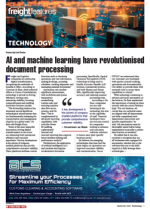The road freight industry is undergoing a profound transformation, shifting from a relationship-driven sector to one focused on efficiency. As technology becomes more integral to operations, carriers are now able to deliver more accurate and consistent services, even as profit margins continue to tighten. Surprisingly, this technological shift has levelled the playing field, enabling new market entrants who can optimise their processes to compete effectively with long-established industry players, said Wichard Sullwald, co-founder product technology at CtrlFleet.“This impact on the road freight industry has been driven by the integration of various pervasive technologies,” he said. “From accurate GPS telemetry and advanced mapping and routing systems to broad and reliable mobile coverage and continuous improvements in browser technologies on both desktop and mobile devices, these advancements have enabled unprecedented levels of visibility and transparency. Road freight carriers can now respond to planning and route-compliance exceptions in real-time and offer precise visibility to all participants in the supply chain.”He added that, as a technology product provider committed to delivering cutting-edge solutions to the road freight industry, it was essential to evaluate technological progress from within. “One notable advancement we’ve observed, not just in our own product but across the industry, is the aggregation of disparate telematics data streams. This innovation provides a level of transparency that was previously unattainable,” he said.Sullwald said efficiency was ultimately achieved by reducing the time required to identify and resolve bottlenecks and operational errors. “Companies are increasingly turning to technology to pinpoint exceptions rather than relying solely on manual processes,” he told Freight News. “A key trend we’re observing is the growing willingness to integrate IT solutions into operational and execution processes. This includes leveraging APIs and ETL processes to integrate data across various platforms, thereby avoiding duplication of effort and minimising human error. Additionally, encoding algorithmic KPIs to f lag incidents or financial performance indicators, and adopting dashboard-like user interfaces instead of sifting through large data sets, is crucial for improving incident management and reducing time-to-action.”He noted that over the past few months, there had been a remarkable shift within a traditionally conservative industry towards embracing technological advancements. “This willingness to push the boundaries and leverage technology in their operations is incredibly rewarding for us as a technology provider,” he said. He added that the biggest challenge currently faced by both small and large organisations adopting new technology was effective change management. “Operations teams that are accustomed to having full control over process f lows are now being required to adapt to systems that drive operations and respond to exceptions, rather than relying on extensive manual efforts in their daily activities,” he explained. “This shift often results in significant push-back or reluctance to adopt new systems, which executive teams must address proactively. However, the benefits of overcoming these change management hurdles are giving companies a notable competitive advantage.” LV

